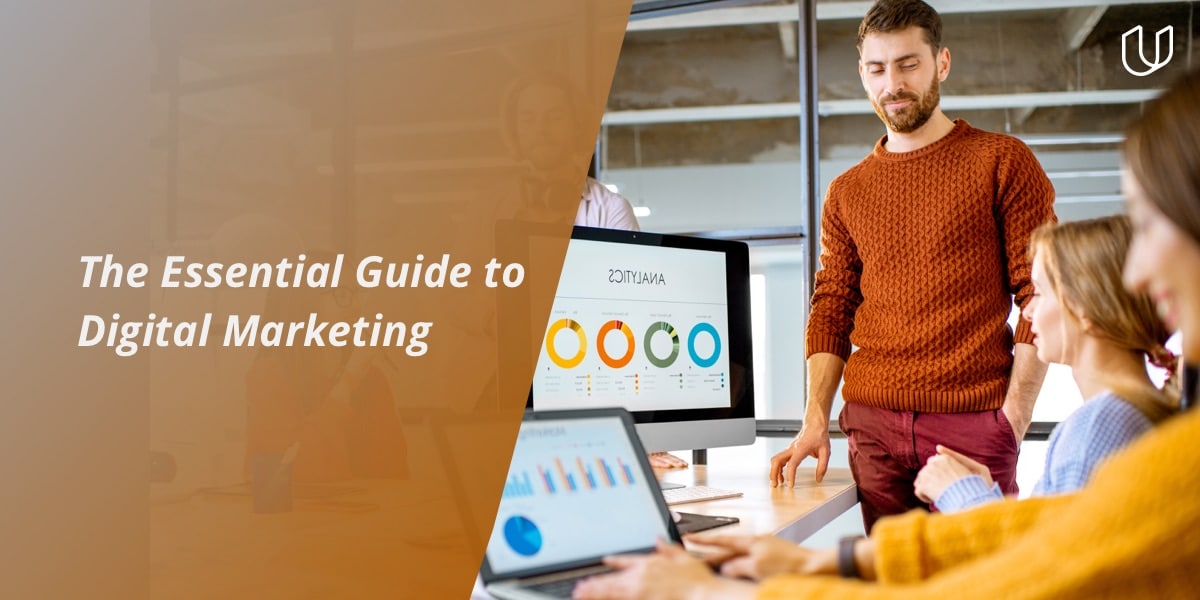For a term that’s thrown around a lot these days, people still know surprisingly little about what Digital Marketing entails.
Digital marketing is a lot more than just a fancy buzzword that you throw in at meetings to sound smart – we’ll tell you that upfront. It’s neither that nor internet marketing, online marketing, digital advertising, or online advertising (all of which, while mostly used interchangeably with the term digital marketing, are actually forms of it). The truth is that digital marketing is a blend of offline strategies (such as SMS and digital displays) as well as online strategies (such as social media, website, and email). Since online strategies make up the majority of any effective digital marketing strategy, they will form the focus of this article.

What is digital marketing?
So really, what is digital marketing? At its core, it’s any form of marketing executed through digital channels and devices. And since the share of people on both is only skyrocketing over time, you get an idea of how big digital marketing actually is. Thus, as businesses are investing more time and money in digital marketing every year, it goes without saying that this is a skill that’s fast becoming critical to most companies.
But what exactly does digital marketing entail? Here’s a lowdown of the broad types of digital marketing in existence today:
Types of digital marketing
Broadly speaking, digital marketing can be segregated into two buckets – online and offline. Since online forms the bulk of this, let’s first cover the offline side. Offline digital marketing consists of all marketing via non-internet-based digital media, such as the radio, television, and mobile phones (through SMS, MMS, ringtones, etc.).
Online digital marketing can involve any, a combination, or all of the following major channels:
Search Engine Optimization (SEO)
This is the process of optimizing online content to rank high in organic search engine results for specific keywords/ phrases. It includes “on page SEO,” which involves creating content around keywords that rank high for search volume (or intent, or both), “off page SEO,” which focuses on backlinks, or links that lead back to your site, and “technical SEO,” which works on optimizing page content, enhancing page load speeds, etc.
Social Media Marketing (SMM)
This involves leveraging social media platforms to market brands, products, or services. While the most popular channels remain Facebook, Twitter, LinkedIn, and Instagram, a large number of businesses are also increasingly using other channels such as YouTube, Snapchat, Pinterest, and WhatsApp. Since a growing number of people are spending time on social media, this is a very popular form of digital marketing, and can help with a variety of business objectives ranging from increasing awareness to converting prospects.
Email Marketing
This is the practice of emailing targeted lists of subscribers/ prospects to promote content and special deals, or share news/ updates. E-mailers usually end with an effective call-to-action (CTA) that directs readers to a website or landing page with the purpose of increasing traffic or leads. Email marketing campaigns often resort to a variety of email formats to achieve varied objectives. Examples include sale/ holiday promotion announcements, loyalty program updates and alerts, subscription newsletters, and educational emails for customer nurturing.
Content marketing
This refers to the practice of leveraging the art of storytelling by regularly publishing relevant, high-quality content assets with the aim of building long-term, strong relationships with your target audience. You may create and promote a large variety of content assets such as blogs, whitepapers, ebooks, product walkthrough videos, thought leadership articles, and infographics to aid brand awareness, organic traffic, lead generation, as well as conversion of prospects.
Pay per click advertising (PPC)
This is a form of online advertising in which advertisers drive traffic to their websites by paying for every click of their ad on a publisher’s site. As opposed to SEO, SMM, and content marketing, which aim to increase organic website traffic, this is a way to “buy” site visits. Google Ads, which allows advertisers to buy top slots on Google’s search engine results pages (SERPs), is one of the most popular types of PPC in existence today. Other popular options include Facebook ads, Twitter campaigns, and LinkedIn sponsored messages.
Search Engine Marketing (SEM)
Also called paid search, this is the process of increasing website traffic through paid advertisements on SERPs. Examples include PPCs, cost per click ads (CPCs), and cost per thousand impressions (CPMs). Google AdWords is one of the most popular platforms for paid search, followed by ads on Bing and Yahoo. One of the biggest advantages of paid search is that it offers advertisers the opportunity to reach customers who are ready to buy. This also makes SEM one of the most powerful and effective forms of digital marketing.
Affiliate Marketing
This is a kind of performance-based partner marketing program in which a third party (who may or may not be an existing business partner) promotes a brand’s product or service in return for a commission. Considering that it’s a revenue-sharing model that’s beneficial to both the brand as well as the affiliate, it has gained immense popularity as a tactic to drive sales and online revenue with relatively less effort than most other marketing tactics.
Google Analytics
Now, one of the best things about digital marketing is that it’s, well, digital. This means that every click, every bounce, and every drop off can be tracked, analyzed, and measured. At least whatever’s online – which is most of it. If you have a blog or a website, you need Google Analytics to know where you stand and where you’re headed – it’s as simple as that. Not surprisingly, it was the most commonly used web analytics service in 2019.
Google Analytics helps you track website activities such as number of visitors, pages per session, session duration, and bounce rates. It also offers valuable insights into critical questions such as:
- Which websites direct visitors to our website?
- Should our website be mobile-friendly?
- How many visitors have converted into leads/ customers?
- How can page load speeds be improved?
- Which marketing activities and site pages attract the most traffic?
- Which blogs have proven to be popular?
In today’s world, when it’s absolutely necessary for companies to have an online presence, Google Analytics helps them understand how well their customers are engaging with their website and apps. All they need to do is sign in, set up their account and property, install the free code they receive in every page of their site (how this is done varies depending on the type of website they have), and set up their goals (such as file downloads, lead generation, or sales). The tracking codes then run and rake in all the data about incoming website traffic, which can be viewed at a high level via dashboards, or at a granular level via more drilled-down reports.
Top 7 reasons to buy into digital marketing

Having started out as just a novel marketing approach, digital marketing today is an integral part of key business functions. Here are the top seven reasons why businesses need to adopt it:Reach and flexibility: Given the pervasive nature of digital media and devices, this is the single channel that affords the highest customer reach. Just over two years ago, 77% of adults in the US owned smartphones. What’s more, mobile phones are increasingly being used to make purchase decisions. Digital marketing offers an easy way to reach all these customers, particularly the mobile ones. Most importantly, it affords marketers the flexibility to leverage a variety of formats and channels to reach various personas. The best part? If you figure out that something isn’t working, you can adapt it on the go.
Affordability: Digital marketing requires a considerably lower budget than traditional approaches such as television and newspaper/ magazine advertising. While specific prices of course vary based on channel and reach, ad spend is typically lower than it is with most other forms of marketing. Thus, it levels the playing field for smaller businesses and empowers them to compete with larger businesses of the likes of Walmart and Amazon.
Scalability: One of the biggest benefits of digital marketing is that it is easy to scale as businesses grow and expand. Once you choose a daily budget and schedule, your expenditure on social media campaigns, search ads, and display ads can be fixed. You may increase your spend as you see results, or cut back if the response is overwhelming and you worry you’ll get backlogged.
Engagement: Since an increasing number of adults are spending more and more time online, digital marketing provides the best way to find customers where they’re most likely to be. Thus, it offers the best opportunity to reach, initiate, and foster direct, one-on-one conversations with customers, making for higher engagement in the long term. Not just that, customers feel heard as well – their messages, comments, and reviews are a great way for businesses to collect valuable feedback about their products/ services.
Trackability: One of the most valuable features of digital marketing is how easy it is to track, which makes it possible to unearth indispensable insights by way of analytics (free or paid). Thus, it’s incredibly easy to measure and analyze RoI as well as effectiveness of each activity. All that needs to be done is to cut back where RoI is low, and step up money/ effort (or both) where RoI is higher.
Targeting: Digital marketing has the unique ability to allow targeting of customers, which means that businesses can focus on specific demographics. This in turn gives them the opportunity to refine their content and make it as relevant as possible for the target market. Highly relevant content ensures a much more effective connect with the audience, which increases the ability to influence purchase decisions.Personalization: Yet another massive advantage of digital marketing is that it provides businesses the ability to hyper-personalize content, even up to the individual level. For instance, deals, offers, and recommendations on Amazon are personalized to cater to observed preferences and tastes. Email marketing, too, can be tailored to nearly an individual level.
7 Key digital marketing jobs – and how to find the perfect one

Given the vastness of the field, digital marketing offers a multitude of roles to choose from. Ranging from product/ tech, content, growth, and social media marketing to SEO, lead/ demand generation, and analytics, the opportunities are nearly limitless – and enough to make the most decisive students/ professionals stop for a second when it comes to making a choice.
While this fact alone makes it all the more important to find the right fit, it’s easier said than done. Just the research can eat up hours on end, and still leave you a little baffled – like when you get lost in a load of Amazon customer reviews. So here’s a list of the seven broad categories in which you’ll find a majority of digital marketing roles:
Product marketing
Product marketing exists at the intersection of product/ tech, marketing, and sales. People in this role typically handle market positioning, go-to-market, competitive differentiation, and market messaging for products. Product marketers help customers (existing as well as potential) understand how to use products to gain the maximum benefits, and sales teams understand how to sell. In a nutshell, product marketing is a cross-functional role that aligns the product/ tech team, the sales team, and the customers, ensuring that everyone’s expectations are met – as realistically as possible, that is.
Necessary skills
Creativity, research, storytelling and communication (oral and written), analytical skills (qualitative and quantitative, for product, buyer, and market), multi-tasking, leadership
Content marketing
Content marketing involves the creation and distribution of relevant, informative, and insightful content – using a variety of appropriate formats and channels – to a well-defined target audience. Great content, besides establishing a connect with and engaging customers, manages to generate one or more of the following:
Website visits
Enquiries of interest
Downloads (of content or trials)Sales
Necessary skills:
Creativity, strong (and grammatically sound) writing skills, editing skills, user empathy, research, flexibility of style and tone, familiarity with SEO best practices, ability to meet tight deadlines, ability to work independently as well as within teams.
Social media marketing
This is all about leveraging platforms such as LinkedIn, Twitter, Facebook, and Instagram to build an audience, expand reach, and foster close-knit communities. The idea is to reach and connect with as many prospects as possible rapidly, and at a massive scale.
Necessary skills
Creativity, strong grasp of social media platforms and best practices, good communication skills, familiarity with various platforms and their typical audiences, understanding of social media management tools and SEO, project conceptualization and management, organic and paid promotion expertise, community management
SEO
SEO is the most effective lever in digital marketing to accelerate brand awareness and inbound traffic. It merges the best of brand intent and user focus to ensure continued discovery, engagement, and loyalty – resulting in highly cost-effective marketing.
Necessary skills
Working knowledge of SEO tools and best practices, strong understanding of Google Analytics, ability to collaborate cross-functionally, proficiency in HTML, sound communication, writing, and competitor analysis skills, robust experience in keyword/ data mining tools
Growth marketing
While this has been around for a relatively shorter time than most of the other roles listed here, growth marketing (or growth hacking, as it’s called by many companies) is a role that every startup is looking for. The reason? It’s the fastest way to accelerate both their revenue and their user base. Simply put, growth marketing is a form of marketing where the only goal is exponential growth. True, all marketers focus on growth – but growth marketers focus only on growth…at the risk of ignoring almost everything else. However, it’s a calculated practice that involves the deployment of a number of methods, disciplices, best practices, and tools that are different from those leveraged by other marketers.
Necessary skills
Marketing, product management, quantitative modeling, data analysis, inclination to experiment, understanding of technology/ engineering/ coding, communication skills.
Marketing analytics
This creates the foundation for intelligent business decisions. It analyzes current trends, user feedback, and community growth and engagement metrics to ascertain success and improvement potential across digital marketing efforts. Marketing analytics measures, analyzes, and manages digital marketing performance across formats, channels, and teams to maximize RoI.
Necessary skills
Sound quantitative and qualitative analysis skills, good communication skills, experience with a variety of statistical and website analytics tools.
Lead/ demand generation
This involves leveraging organic as well as paid means to drive brand interest, resulting in the generation of relevant, sales-qualified leads.
Necessary skills
Strong experience with Google business, marketing, and analytics tools, proficiency in SEM and Facebook Ad Manager, strong grasp of performance analytics
If you’re thinking of a career in digital marketing, there’s a ton of jobs to choose from. The best way to choose is to find one that aligns closest to your own skills and experience, so that you may leverage and build on them as needed. For a list of the top 10 jobs in digital marketing today, click here.
Digital marketing strategy
Considering the current consumer landscape, a large part of any business’s marketing strategy is going to be digital for a long time to come. It’s just the most effective way to observe and reach a massive consumer base. But when growing a business, the relentlessly dynamic nature of the digital landscape can quickly get overwhelming – unless there’s an agile digital marketing strategy in place.
A good digital marketing strategy is an organized list of actions aimed at achieving clearly defined digital marketing goal(s) by leveraging a combination of owned, paid, and earned media channels. Depending on the business scale, the strategy may be simple and straightforward, or may involve multiple sub-strategies, each with different goals and dynamics. However, an overarching strategy is essential to ensure that things stay on track.
Building a digital marketing strategy, therefore, is a comprehensive exercise that entails several cross-functional activities. Here’s a list of the main steps you can expect:
- Identifying buyer personas
- Defining goals
- Determining necessary tools, resources, timelines, metrics, and budgets
- Evaluating existing and new resources
- Planning at the most optimized cost possible
- Executing and coordinating campaigns
- Measuring, analyzing, and adjusting campaigns to close gaps
Every digital marketing strategy is different, and tailored to specifically suit the business that it has been created for. Thus, while it’s impossible to have a one-size-fits-all, templatized approach, all great strategies have two things in common – they clearly define their desired goal(s), and they map out all planned actions that are required to achieve the outlined goal(s).
Does digital marketing work for everyone?

For the same reasons already listed several times above (in a nutshell, everyone’s always online), digital marketing works for any business, and in any industry. The trick lies in knowing what strategy to adopt, and how to implement it to maximize reach and RoI.
For instance, a B2B business might leverage digital marketing via online lead generation followed by face-to-face nurturing and development, while a B2C business may find it effective and convenient to keep the entire process online. Similarly, a B2B business might focus on LinkedIn as its primary social channel, while a B2C company may rely more on Instagram, Facebook, and Pinterest. Success stories abound. In B2B, they include the likes of SAP, Salesforce, CB Insights, Bosch, and Deloitte, while in B2C, Starbucks, Tesco, Spotify, and Lush Cosmetics make waves with creative digital campaigns.
To conclude
Digital marketing is much more than just social media posts and viral videos. It’s a planned, ongoing, calculated strategy that has to be built on and adjusted over time to yield the best results. And while it isn’t the only way to achieve marketing success, it’s definitely a skill that every marketer worth his/ her salt will have to master soon, given the sheer volume of existing and potential customers spending an increasing amount of time on digital devices and platforms.
Also, the versatile, agile nature of digital marketing makes it perfect for businesses looking to diversify their lead generation strategy in a commitment-agnostic, data-backed, iterative manner till they see the results they’re aiming for. As businesses continue to increase their spend on digital marketing, the demand for skilled professionals in the field will only grow. If you’re interested in building a career in digital marketing, we have just the thing to get you started – a power-packed, quick course that gives you a real-world view of running live campaigns and a lowdown on critical topics from top experts. Click here to find out more, or to view details of our digital marketing syllabus. We also offer a variety of other turnkey courses aimed at advancing careers (whether you’ve just started out or are looking to avoid flatlining / accelerate mid-career growth) via our School of Business.
As innovative technologies continue to emerge and evolve and consumers grow increasingly smart and discerning, the digital marketing world is one that’s in constant flux – are you ready for it?



